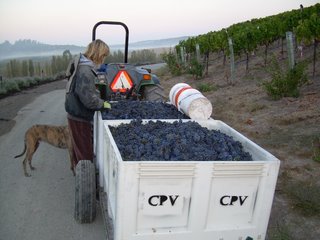
On Sunday, September 24, we began harvesting Pinot Noir. We were up and in the fields at 5:30 AM, which turned out to be just a touch too early, as it was still too dark to see the fruit. We were picking Pinot Noir, clone 667. For more info on Pinot Noir, go here:
http://www.winepros.org/wine101/grape_profiles/pinot.htmThe process goes as follows. First, position the picking bins on the trailer behind the tractor. The picking bins' dimensions are 4' x 4' x 2' (W x D x H), and they are made of food grade plastic. Drive the tractor down a row of vines, with the crew following. The picking crew fill 5 gallon plastic buckets with freshly picked clusters, and runners empty these buckets into the picking bins. One or two people sort fruit as it is placed in to the picking bin, throwing out underripe fruit, leaves, and other MOG (Material Other than Grapes). When both picking bins are full, the tractor heads back to the barn for a fresh set of bins. The full bins are kept in the shade until all of the days' fruit is harvested and we are ready to go to the winery.
The bins are then loaded via forklift onto a flatbed truck, and are strapped down securely. Each bin holds roughly 900 pounds of fruit, and at premium Pinot Noir prices, each holds several thousand dollars worth of fruit. Care is taken to ensure the cargo reaches its destination.
At the winery, the fruit is unloaded with another forklift, weighed, and stacked up to be crushed. A forklift with a bin dumper is used to dump the fruit into a vibrating hopper, which feeds a conveyor belt/incline ramp that is called a sorting table. The fruit is sorted a second time by hand on the sorting table and is fed by the conveyor belt into a destemmer/crusher, which not surprisingly destems and crushes the fruit. The crushed berries are now a mash of juice, skins, and seeds, which together are called "must", which falls from the destemmer/crusher into a fermenter. The fermenter is similar to the picking bin, but twice as tall. The stems fall out of a chute on the destemmer into a empty picking bin.
A small amount of sulphur dioxide is added to the crushed fruit to prevent spoilage and spontaneous fermentation, and a generous amount of dry ice is added to keep the temperature down. The dry ice creates a very cool "Land of the Lost" style fog effect. The must will sit in the fermenter and be stirred twice a day for a few days before the fermentation process starts. This pre-fermentation rest is called a cold soak and really helps to extract flavors from the skins. The stirring process, called a "punch down" is accomplished by placing a board across the top of the fermenter, climbing up, and using a large tool similar to a giant potato masher to knock the skins back down into the juice.
I then cleaned two more fermenters for today (Monday) and we cleaned the sorting table and floor, as grape remains are everywhere. We then loaded up the empty picking bins and headed back to the farm for a well deserved shower, dinner, and night of sleep.
We did another small harvest/crush today, but it was small enough that Wes and I had plenty of time to play golf this afternoon. It's a rough life.
There are more pictures of all of this here:
http://pg.photos.yahoo.com/ph/weber12398/album?.dir=3b6fscdCheers!


